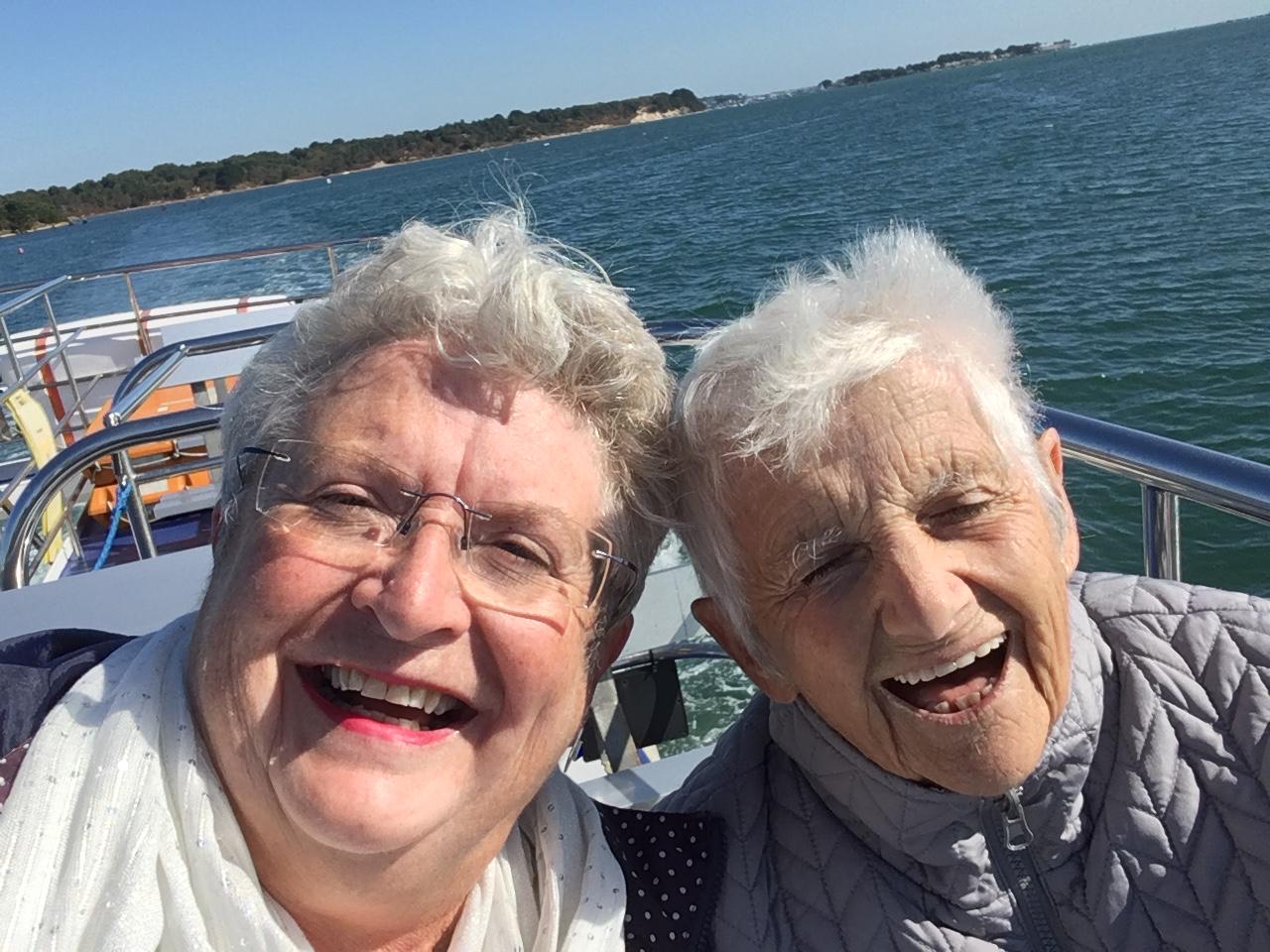
Meet our new Chair of Trustees Jason Holt
February 6, 2025
2025 Supporters Ball raises nearly £7,500
March 7, 2025In June 2019, Sue woke up puzzled to find herself in a bed looking at the ceiling of the Bristol Royal Infirmary’s Intensive Care Unit. Her first thought was, “Oh. This looks like a hospital?”
Sue learnt that she had suffered a cardiac arrest a few days before on 5 June 2019 while settling her mother into a nursing home for the first time just outside Bristol. It has taken several years since to piece together the full picture of what happened that day and why. Her journey of discovery finally led her to Great Western Air Ambulance Charity (GWAAC) in 2024.
During a visit to the charity’s airbase, Sue learnt more about what happened that day and about what GWAAC’s Critical Care Team did to help save her life.
This is Sue’s story, pieced together from fragments of her memory and from those who came to her aid.
An unexpected collapse
Sue had taken her mother upstairs to her room in the nursing home. She then popped back to the car to collect her mum’s belongings. The next thing she remembers is waking up in the hospital.
Sue was told that she collapsed on the narrowest flight of stairs in the building. She had been carrying her mother’s suitcase up to her room when she suffered a cardiac arrest.
Sue said, “I had no clue whatsoever that this was going to happen. The fact that I walked up the stairs with the suitcase and didn’t get the lift suggests I didn’t feel unwell. I would have taken the lift if I felt unwell. It was at the top of the second flight that I collapsed.”
Luckily, Sue fell forward on top of the suitcase, rather than backward down the stairs. It was also lucky that a member of the nursing home’s staff found Sue within less than a minute of her collapse. Immediately, the home’s well-rehearsed plans for what to do in case of a cardiac arrest swung into action.
On the fifth anniversary of her cardiac arrest, Sue went back to the care home to thank the staff who helped her. She learnt that the care home had called 999 while someone started CPR. Sue says that the care home staff were all well-trained in CPR and how to use a defibrillator.
GWAAC rush to Sue’s aid
Minutes after her collapse, at 15:26, GWAAC’s specialist team was dispatched to provide urgent lifesaving care to Sue.
Critical Care Doctor, James Tooley and Specialist Paramedics in Critical Care (SPCC), Jack Kilminster and Matt Robinson flew to the scene in the capable hands of Pilot Jim Green. SPCCs James Yates and Pete Reeve jumped into one of GWAAC’s fully equipped critical care cars and met the helicopter team at the scene.
The crews were there within minutes; they raced inside and up the flight of stairs to help Sue. Road paramedics were already providing advanced life support and had achieved a return of spontaneous circulation (ROSC). SPCC Jack said, “Our initial thoughts were that Sue’s sustained ROSC required an immediate pre-hospital anaesthetic [an induced coma] to make sure we gave her the best possible chance of a good outcome following her cardiac arrest.”
The GWAAC team, with the help of the road paramedics, safely moved Sue out of the care home and into a road ambulance where she was conveyed to the Bristol Royal Infirmary (BRI)—the home of the Bristol Heart Institute. This is where she would receive the best investigation and onward care for her needs. Dr Tooley and SPCCs Jack and Matt travelled with Sue in the ambulance to monitor her and provide further treatment if her condition worsened.
Recovery
The day after Sue came around from her induced coma, she was up and about talking to other patients. She said, “It was amazing really, I’d narrowly escaped death and yet I felt perfectly OK.” She chuckled, “They hung a heart monitor around my neck that sent a signal to a transmitter – it meant I could wander as far as a coffee shop that was closed for refurbishment but not as far as the one that was open.”
Sue doesn’t remember having any pain or bruising from the CPR or feeling groggy when she came out of the coma. “Apparently, I was completely coherent but the stories afterward suggest I didn’t remember everyone who visited me in hospital.” She said, “The worst thing about the whole experience was the worry it put my mum through when she had just moved into a nursing home to recover from a hospital stay herself.”
Sue had lots of tests in hospital to try and identify the cause of her cardiac arrest. The results showed she had low potassium and calcium levels, probably caused by the tablets she was taking for her blood pressure. It then also came to light that she has inherited a heart problem called Long QT Syndrome which affects how the heart beats. Sue says, “It [her cardiac arrest] was just waiting for my electrolytes to be all messed up. The immediate fix for me was different tablets for my blood pressure.”
The degree of Sue’s QT Syndrome was marginal and doctors decided after she’d been in hospital almost three weeks to fit her with an ICD (Implantable cardioverter-defibrillator) just in case. Sue now needs to avoid going through older airport security scanners but new ones are being introduced that she can use in the same way as anyone else.
A positive mindset and meeting the crew
Sue says, “Overall, the experience has felt very positive. I’ve enjoyed being part of a follow-on study with GWAAC’s Professor Benger at the BRI; I’ve learnt so much from him. And I’ve enjoyed learning all about GWAAC and meeting the crew who helped me.”
After Sue realised how lucky she’d been, she resolved to give a significant donation to GWAAC as a thank you and each year since, she has given the same amount to other causes such as the BRI and Southmead Hospital. Her first donation prompted contact with GWAAC but she was a little cautious initially: “I didn’t know if I should ask to visit the helicopter base or if the crew would want to see me. I thought they might be too busy but in the end meeting Specialist Paramedic Jack was brilliant!”
She said, “I wish I’d visited earlier but the COVID-19 pandemic got in the way and it got re-arranged a few times.”
SPCC Jack said, “It was fantastic to see Sue doing so well and her recovery highlights the importance of early CPR and defibrillator use. A big thanks to the staff at the care home and their quick actions that almost certainly played a big part in Sue’s survival. It was a pleasure answering any questions Sue had during her visit.”
Sue is making the most of feeling well and you’ll see her out and about volunteering at popular Bristol attractions such as the M Shed Museum. She is also Chair of the Friends of Bristol Museums. She remembers a time when she was volunteering outside Blaise Museum for an archaeology festival: “I saw GWAAC’s helicopter circling overhead and it felt very poignant. I remember joking at the time that perhaps they’ve come to wave to me!”
Sue says, “I will always be grateful to the many people who ensured that I not only survived my cardiac arrest but returned quickly to full health. That includes the care home team who kept me alive and oxygenated until the paramedics arrived from South Western Ambulance Service Foundation Trust, the Critical Care Teams from GWAAC and the staff at the Bristol Royal Infirmary, particularly in the Heart Institute. And of course, the family and friends who went through much more of a traumatic time than I did [I slept through the worst bits. . .] and gave me so much support.”
Sue’s words of advice for former GWAAC patients
“It was a totally positive experience for me chatting to SPCC Jack and Supporter Engagement Coordinator Jenny at GWAAC’s airbase. I was given an insight into how things work behind the scenes of an air ambulance charity and it was really comforting to know that GWAAC is here. I learnt from Professor Benger that ambulance and air ambulance crews often don’t hear the outcome of the patients they’ve helped. I now know that GWAAC always welcomes former patients getting in touch. I’d encourage anyone to reach out if they have been treated by GWAAC.”
“It was fantastic to see Sue doing so well and her recovery highlights the importance of early CPR and defibrillator use. A big thanks to the staff at the care home and their quick actions that almost certainly played a big part in Sue’s survival. It was a pleasure answering any questions Sue had during her visit.

“It was amazing really, I’d narrowly escaped death and yet I felt perfectly OK.”



